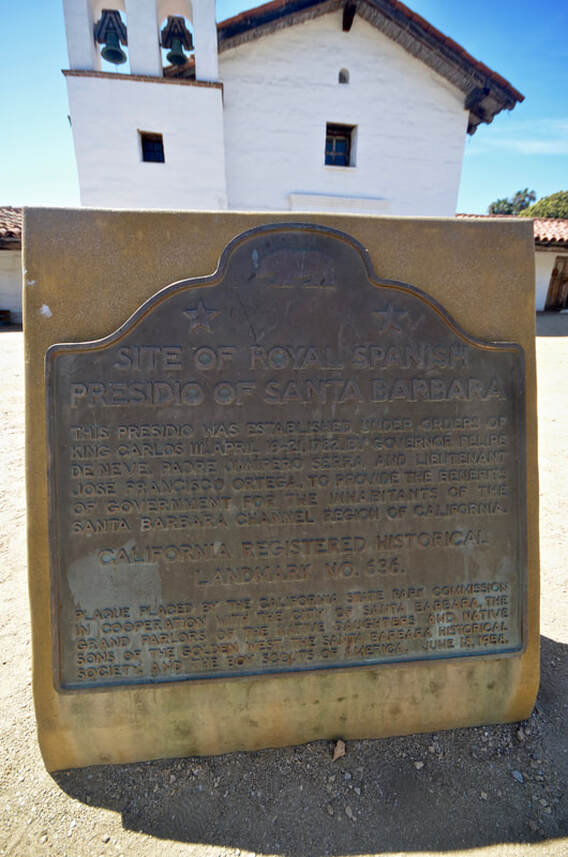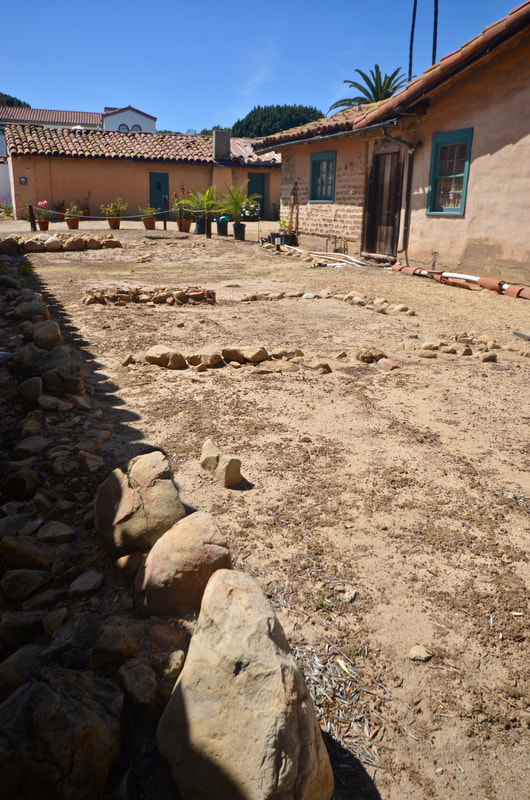104.The Birthplace of Santa Barbara
|
By Miguel Pérez
The architecture resembles that of a Spanish mission, with its white, adobe walls and rows of family living quarters surrounding an open plaza. But missions often are built like forts, and this time it is indeed a fort that we are visiting. We may be in downtown San Barbara, California, a beautiful, modern American City, but we are also at the 1782 Presidio Real de Santa Barbara, the last military outpost built by Spain in the New World and a huge tourist attraction. This fort, which preceded the nearby Mission Santa Barbara by four years, is the birthplace of what is now a city and county of some 448,000 people. In the late 1700s, the pueblo of Santa Barbara developed around the Presidio, because it offered protection for its residents. Mind you, construction on Mission Santa Barbara started in 1786 at about a mile and a half inland, but it was meant for another group of residents: The Chumash (Barbareño) neophytes who built it and converted to Catholicism. It will be the next stop for our Great Hispanic American History Tour! But first we have to spend some time at this fort, which is now a State Historic Park (mostly reconstructed since 1966) and where, following a self-guided tour pamphlet, you truly gain "an understanding of what life was like at a Spanish colonial frontier outpost." Following orders from Spanish King Carlos III, who wanted to secure Alta California against British or Russian encroachment, the Presidio site was chosen by Felipe de Neve, the fourth governor of Las Californias. Neve determined that the area had ample building supplies and water resources, but was yet vulnerable to attacks. He picked a spot near the harbor and yet somewhat sheltered from severe storms. The only thing he could not forecast were earthquakes! Although the Presidio was never attacked, it was devastated by several earthquakes in the early 19th century. And although most of it has been rebuilt over the years, two portions of the original presidio quadrangle still survive: Canedo Adobe, a one-family home now serving as the Presidio's Visitor Center; and El Cuartel, the soldiers quarters, a 1788 adobe structure which is the oldest building in Santa Barbara and the second oldest standing adobe in California. The Presidio is the site of many archaeological findings which, in turn, offer a glimpse of life there between 1782 and 1810. Archaeologists have not only uncovered the tools that were used for food preparation - including knives, forks, spoons, plates, cups, and ceramic cooking bowls - but also bones - fish, pig, cow, horse, deer - that reveal the components of their diet. "The presence of identifiable seeds, pits, husks, and cobs provides a glimpse into the various crops prepared for meals at the Presidio," the self-guided tour pamphlet explains. Here, you learn that many of the Presidio soldiers were trained craftsmen, such as carpenters and stone masons, and part of their duties included construction and maintenance of the Presidio buildings. Nevertheless you can see that the fort's primary purpose was defensive, because of the thickness of the walls - nearly four feet across! Here, you learn that family living quarters were about 22 feet long and 14 feet wide, and each had a small backyard. The original floors were hard-packed dirt and the ceilings were made of reeds lashed together with rawhide strips. The doors usually were covered by rawhide and the windows by stretched, dried, sheep's stomach lining. After the initial construction, when one residence was converted into a two-story observation tower, "it allowed an unobstructed view of the surrounding area," the pamphlet says. "The mission and the ocean would have been easily seen from here." In 1966, State Parks acquired El Cuartel through a partnership with the Santa Barbara Trust for Historic Preservation, which has supervised the park's expansion and recreation. Reconstruction of the Presidio's chapel, courtyard and rooms along the entire quadrangle has been based on exhaustive historical and archaeological research, usually to restore damage caused by earthquakes. In fact, the Presidio's original chapel served as the town's main house of worship until it was destroyed by an earthquake in 1857. The chapel, rebuilt in 1985, with its very colorful sanctuary, still serves as community gathering center, hosting theater performances, concerts, lectures and weddings. "El Presidio de Santa Barbara State Historic Park," still has an active archaeological project and impressive exhibits of the findings. It is a California Historical Landmark and it is listed on the U.S. National Register of Historic Places. Today, the Presidio's plaza features a statue of King Carlos III, who ruled Spain from 1759 until his death in 1788. He also ordered the construction of presidios (forts) in San Diego, Monterey and San Francisco. The statue was donated to the City of Santa Barbara by King Juan Carlos I and Queen Sofia in 1982 - to commemorate the 200th anniversary of the founding of the Presidio. "While some members of the community welcomed the gift as a symbol of the City's Spanish heritage," the tour pamphlet explains, "other felt that it represented the colonial oppression of California's indigenous peoples." But wait! Don't you see Spanish heritage everywhere you look here? Isn't all of California a symbol of Spanish heritage? Go figure! |
En Español:
|












































